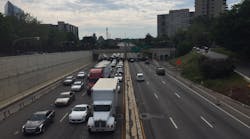One of the major findings from the 27th annual State of Logistics report is that “gaps” in infrastructure and “accelerating trends for speed” will increasingly put pressure on a logistics system not designed for e-commerce driven “last mile, last minute” delivery service.
“Consumer expectations are changing. They want their products delivered fast and they don’t want to pay a lot of money for delivery,” noted Marc Althen, president of Penske Logistics, in this year’s report. “Shippers are struggling to meet the challenges these expectations create.”
Authored by Sean Monahan, a logistics expert with consulting firm A.T Kearney, published by the Council of Supply Chain Management Professionals (CSCMP) and presented by Penske, this year’s State of Logistics report also projects that the logistics industry will enter a “new era” over the next decade plagued by a variety of “disruptive forces” including the Internet of Things (IoT), robotics such as self-driving trucks, and 3D printing.
Monahan noted that several “operational constraints” such as regulations, the truck driver shortage, and “infrastructure bottlenecks” are evolving “at breakneck speed” and threaten to fundamentally change the rules of the logistics game – and create both difficulties and opportunities for the trucking industry as well.
“The [logistics] market has also seen an increase in shipper demand for visibility and control into all transportation management activities and assets in order to enable their optimization,” he said.
Those are just some of the forces Monahan predicts will disrupt the logistics industry’s “fundamental elements” at a pace that is “more exponential than linear.” Some of those “other forces” include:
- Technologies that will create step-change efficiencies in connectivity, labor, and assets;
- Macroeconomic trends that will dictate new trade flows;
- Consumer requirements that will stretch capabilities;
- The aforementioned operational constraints that will change the rules of the game.
Monahan also envisions four different “scenarios” that might develop based on whether or not the logistics industry – trucking included – adapts to this “exponential” pace of change:
- Scenario 1: Cruisin’ Down the Highway. Thanks to a truly open technology market, major motor carriers are able to deploy fully autonomous commercial vehicles for cross-country transport, helping to alleviate congestion. Supply chains are fully integrated; warehousing and transportation get managed as an end-to-end offering in order to maximize IT [information technology] efficiencies and minimize the length of transportation flows. Shippers have more choice of supply and can capture value through better pricing and higher service. Regulators understand and trust technology.
- Scenario 2: Stop Signs and Red Lights. Fierce operational constraints, including a devastating driver shortage, high fuel prices, and regulatory barriers to new technologies such as autonomous vehicles and robotics, deeply affect the transportation industry. In the face of regulations, only the strong and most easily adoptable technologies are able to flourish – and only in the hands of those able to invest for the long term.
- Scenario 3: Middle of the Road. This scenario is the closest to the status quo in today’s logistics market, noted Monahan. Transportation automation capabilities improve only incrementally, even as the operating environment continues to be relatively unconstrained. Warehousing facilities are regional or central, as shippers maximize the use of transportation – with limited use of robotics – in order to keep total ownership costs down. Customers have a few more choices in this market, but no distinctive competitor emerges. Regulators are business-friendly and rational.
- Scenario 4: Dead End Street. Regulators are inflexible and hinder the entrepreneurial spirit of the U.S. market. The limited technological advancement and increased cost of regulatory compliance shakes out supply markets, creating higher costs for consumers with limited service differentiation. Great expectations remain unmet.
“Adaptability to these potential changes will define the future winners and losers of the [logistics] industry,” Monahan stressed.



